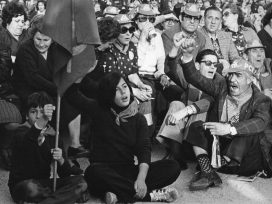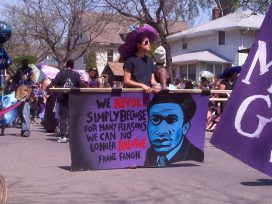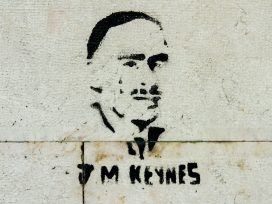Frantz Fanon died at the age of just 36 on 6 December 1961 in Bethesda, Maryland, just a couple of months before the Algerian struggle for independence – a struggle to which he devoted so much of his life – culminated in the nation’s declaration of independence on 5 July 1962. Fanon’s impact on postcolonial theory and practice has been huge and his writings have also been important in the wider context of anti-racism. In this interview with Glänta editor Göran Dahlberg, the Swedish historian of ideas, Michael Azar, who has been reading Frantz Fanon for the past 25 years, explores the legacy of his work by focusing on a few core concepts.
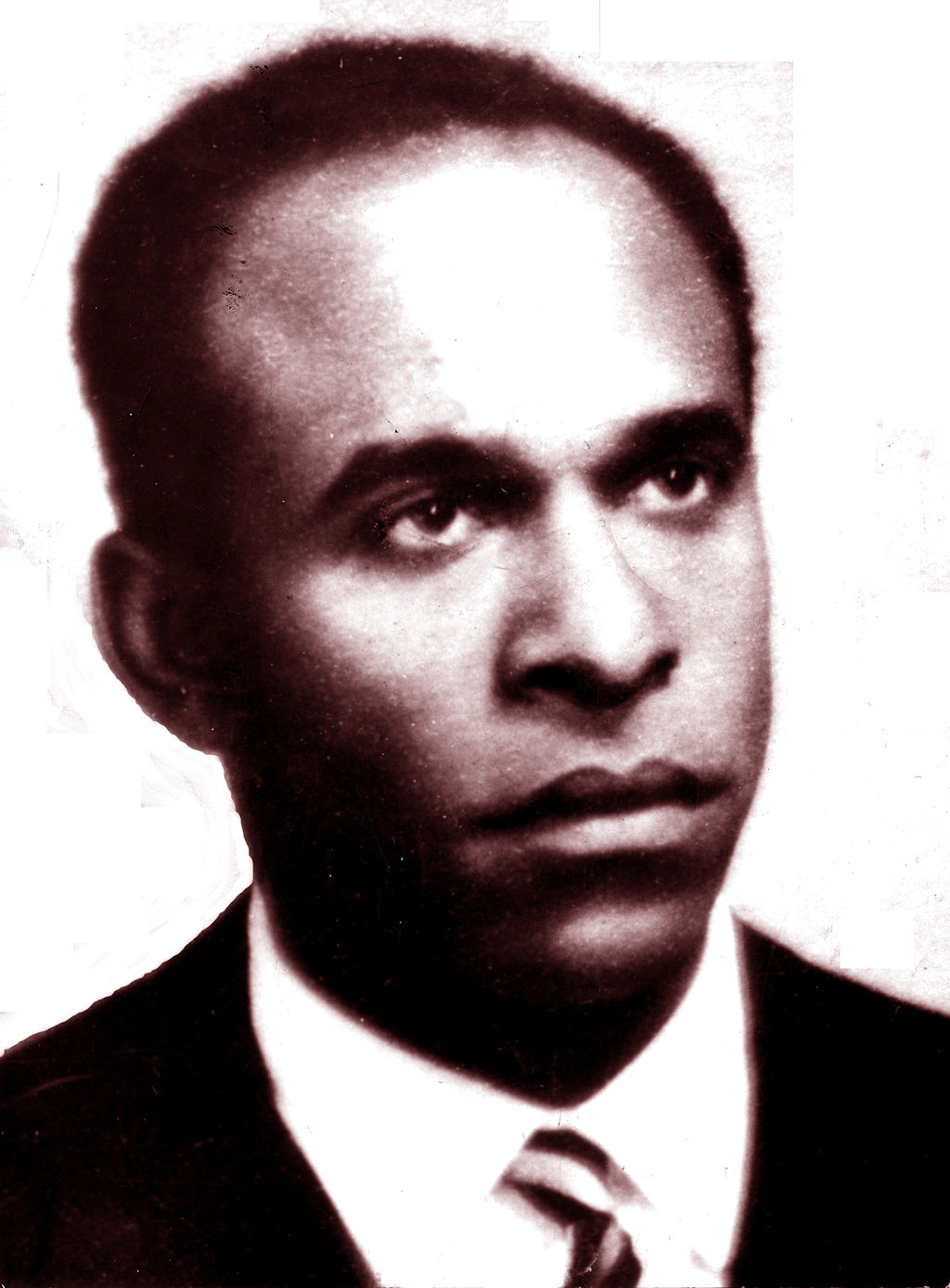
Portrait of Frantz Fanon (1925-1961)
Photo uploaded by Pacha J Wilka, CC BY-SA 3.0, via Wikimedia Commons
Göran Dahlberg: So, why Fanon?
Michael Azar: I was a teenager when I first discovered Frantz Fanon. Owing to my Lebanese background, I had always been eager to know more about the history of French colonialism, and Fanon helped me to better understand what was really at stake in the anticolonial struggles of Lebanon, Algeria, Vietnam, and elsewhere. Fanon also aided me in comprehending the postcolonial condition and the growing racial tensions in Europe, including Sweden, where I grew up.
Later on, during my studies at the department of History of Ideas in Gothenburg, Sweden, I decided to read Fanon more carefully, focusing primarily on his analysis of the anomalies and double binds inherent to the struggle against racism. In his commentaries on thinkers such as Hegel, Sartre, Césaire and Lacan, Fanon is utterly attentive to the spiritual self-estrangement involved in many kinds of anticolonial critiques. When you critique something, Fanon says, you always run the risk of becoming the mirror image of the very thing you are critiquing.
Göran Dahlberg: Does this dialectic also apply to Fanon’s understanding of Anti-colonial and revolutionary violence? And is the violence of ”the wretched” (The wretched of the Earth being the title of his last book from 1961) always justifiable?
Michael Azar: Fanon’s body of work can be read as an attempt to understand the physical, structural and psychological dimensions of colonial violence. He describes colonialism as a system that brings violence into the homes and the minds of the colonized subjects, dehumanizing them at the core of their being. It is a Manichean order that splits the world in two opposing parts – colonizer and colonized, master and slave, settler and native, good and evil, civilized and barbarian.
The dividing line between the two is guarded not only by police stations and machine guns. It is also upheld by ideological assumptions, perpetuated in the colonial subject by means of ideological state apparatuses. For colonialism to perpetuate itself, the colonizer must not just preserve his own image of the colonized as an inferior race, he must also succeed in internalizing the same denigrating image in the mind of the colonized.
This insight is at the center of Fanon’s writings on violence, and it stems from his own experience as a colonized subject, first in his native Martinique and then, later, in French Algeria where he began working as a psychiatrist in the early 1950s. In Algeria, particularly after the 1954 outbreak of the revolution, he witnessed how the brute violence of the settlers permeated every nook and cranny of Algerian society, turning the entire country into a ‘breeding ground for mental disorder’. The French colonial machine was ruthless in its crackdown on the uprising, responding with torture, rape, napalm bombs, summary executions, etc.
The daily horrors of the Algerian war provide the immediate setting for Fanon’s assertion in The Wretched of the Earth (1961) that colonialism is a system that will only yield when confronted with even greater violence. This does not necessarily make him into “an apostle of revolutionary violence”, as some commentators have put it. Fanon simply notes that the colonizer himself has shown the colonized which way to go if he wants to get rid of the colonial system.
Deeply immersed in the revolutionary tradition of 1789, Fanon is fully aware of the article in the Declaration of the Rights of Man and of the Citizen which states that resistance against oppression is an inalienable human right. And we must never forget that Fanon himself took up arms during the Second World War, with the explicit aim of liberating France and Europe from the yoke of Nazism. In his view, the Algerian revolution was nothing less than a continuation of both the French revolutionary tradition and the French resistance movement.
Still, Fanon’s analysis of revolutionary violence extends beyond the mere physical removal of the Manichean order. There is, he notes, another crucial element to the counterviolence of the colonized subject: true decolonization requires a cleansing of the mind. Much like Steve Biko – who was a diligent reader of his Martinican predecessor – Fanon argued that one of the most powerful weapons available to the oppressor is the mind of the oppressed. Profoundly inspired by Hegel’s master-slave dialectic, Fanon stresses the importance of overcoming fear of death in the struggle for freedom and recognition. Violence is ‘cathartic’ in so far as it liberates the slave from his self-inflicted passivity and abasement before the master.
In a decisive passage, Fanon affirms that the well-known principle that ‘all men are equal’ comes to a head in the colonies from the moment the native proclaims that the settler’s life is of no greater value than his own. Fearlessly reclaiming his place among free men, the gaze and voice of the colonizer can no longer turn the colonized into stone.
On the other hand, Fanon cautions that revolutionary movements must be careful not to replace one barbarism with another. You have to know exactly when, where and how to make use of violence – and for what specific reason. Toward the end of his life, Fanon served as a roving Algerian ambassador in the campaign for national liberation across Africa. In doing so, he highlighted many of the shortcomings and dangers of the anticolonial struggle and firmly criticized certain nationalists for reproducing the very Manicheism they claimed to be fighting. For a ‘new humanism’ to come about, ethnically and religiously inspired nationalism must be transformed into a consciousness of social and political needs.
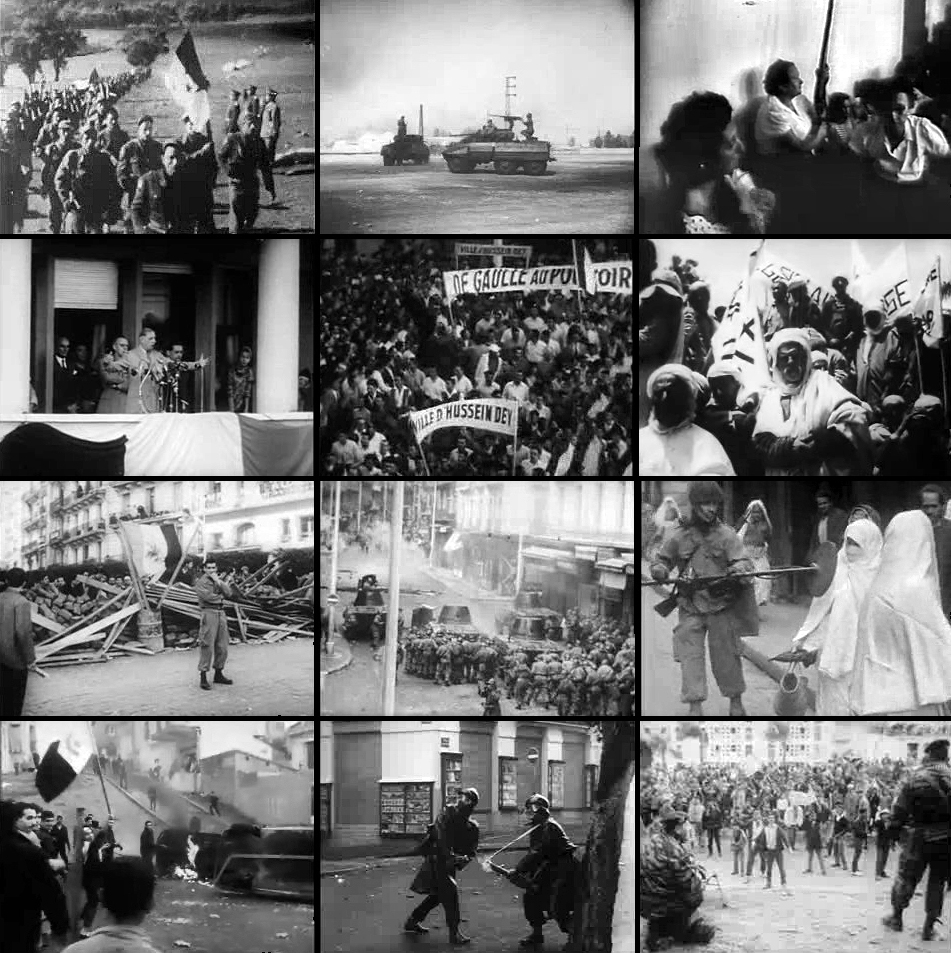
Collage description: (first row) Muslim rebels army ALN; French Army M8 Greyhound patrol; French settlers take up arms after the August 1955 Constantinois massacres. (second row) Charles de Gaulle’s famous speech of June 4 1958 “je vous ai compris”; French settlers with banners saying “De Gaulles to power” in Algiers May 13 1958; Muslim veterans gathered in Algiers’ Government Building in 1958. (third row) Barricades week French settlers uprising in January 1960; French settler FAF rioters throw stones to French Army M8 Greyhound armoured cars; French Army soldier use metal detector to check if muslim women wearing niqab are bomb-couriers. (fourth row) FLN muslim rebels riot in Algiers’s European quarter in December 10 1960; French Army national guard Gardes Mobiles use tear gaz riot gun; FLN muslim supporters face to face with French paratroopers during the December 10 1960 protest.
Photo by Madame Grinderche, Public domain, via Wikimedia Commons
Göran Dahlberg: In Black skin, White Masks (1952), Fanon identifies two diverging forms of racism within Western thought: anti-Semitism and Negrophobia. Can you spell out the difference between the two?
Michael Azar: In the first case, anti-Semitism, the Jew is represented as a danger primarily on an intellectual level, and is therefore attacked because of his historical, cultural and religious identity. In the other, the black male is perceived as a threat on a corporeal level, and he is accordingly assailed by virtue of his alleged dark and primitive instincts.
Dissecting the myth of black male sexuality, Fanon concludes that it is as a way for the colonizer to justify his endeavor as a civilizing mission. In consonance with this narrative, the European colonizer has been bestowed with the arduous burden of spreading Reason, Culture and Enlightenment to backward peoples who have no history and are hardly distinct from Nature itself, governed solely by beastly passions and genital desires.
Fanon goes on to argue that this myth serves to rationalize the colonizer’s actions. It is, he says, a classic case of scapegoating. Recognizing on some level that the colonizer’s history of slavery, exploitation, and repression puts him in a position of guilt, he fashions the colonized as the quintessence of cruelty and barbarity. In addition to this enforced “enlightenment”, the colonized peoples need to be protected from themselves. By exerting heavy-handed control and guidance over this purported enemy of all good values, the colonizer averts the punishment he (unconsciously) deems himself worthy of.
For all that, the fixation on the sexual potency and savagery of the black man – the fantasy of the Other’s unrestrained enjoyment, to put it in Lacanian terms – is not without negative effects on the colonizer himself. It tends to stir up ambivalent emotions within him so that he is relentlessly torn between hatred and love, aversion and admiration – not to mention repressed homosexuality. In Fanon’s view, these ambiguous impulses are embodied in the specific kinds of violence that are meted out against the black body. No anti-Semite, writes Fanon, would come up with the idea of castrating the Jew. He is either killed or sterilized. “The Negro, however, is castrated. The penis, the symbol of manhood, is annihilated, which is to say that it is denied.”
Göran Dahlberg: Fanon’s analyses of the colonial situation are informed by different schools of thought, notably Existential Phenomenology, Psychoanalysis and Marxism. When he focuses on ‘the lived experience’ of black people, he puts these tools to work to discern the ways in which black people are pressured to conform to the colonial imperative ‘turn white or disappear’. How are we to understand this conceptual figure in Fanon’s work?
Michael Azar: Let us turn back to the Manichean dividing line that splits colonized society into two conflicting parts. As I already mentioned, this division is not upheld by concrete violence alone. It is also bolstered by an ensemble of institutions designed to create docile subjects, beginning with the educational system that teaches native schoolchildren that they will one day gain access to the other side of the dividing line: the prosperous, favored, and purportedly superior side. All this naturally depends on the condition that they adopt French culture and language, including the idea of France as the very apex of civilization – that is to say, on the condition that they turn themselves into agents of the civilizing mission, embarking upon an incessant struggle against the horrid barbarian within themselves.
The colonized, writes Fanon, is ‘elevated above his jungle status in proportion to his adoption of the French way of life‘. Constantly subjected to this incentive structure – ‘turn white or disappear’ – the native populations of the Antilles are at risk of internalizing it and turning it into an inferiority complex. In Black Skin, White Masks, Fanon examines how the native’s endorsement of the colonial mindset is played out on a daily basis between teachers and pupils, parents and children, men and women.
‘Even at home when I make too much noise, I am told not to play the Negro’
Fanon was himself one of these young schoolchildren who learned how to speak ‘real French’, quote Voltaire and Rousseau, and claim superiority to the purported primitive Africans still living in the jungle. He clearly identified himself with French culture, seeking recognition from the representatives of the French motherland to the point that he, still a teenager, decided to put his life on the line for France by joining the Free French Forces. ‘Why all this talk about a black people, of a Negro Nationality. I am a Frenchman’, Fanon declared in the beginning of the 1950s. ‘I refuse to be considered as an outsider.’
In a way, Fanon’s writings could – at least to some degree – be understood as an expression of his own painful struggle with the inexorable racism of French colonialism, which denied him recognition because of his origin and skin color. Fanon’s experience as an outsider in both France and Algeria is at the heart of his assertion that the colonized subject must choose himself from within a distorted situation. Under colonialism, he is compelled to self-identify as either White or Black, French or Arab, Civilized or Primitive, instead of transcending them both through the pursuit of a new Man and a universal brotherhood.
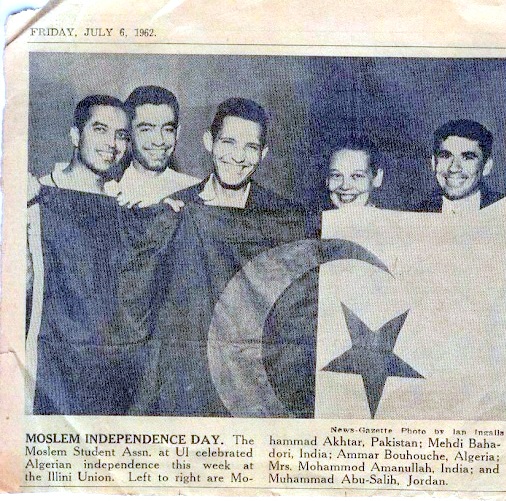
Celebrating the first day of the independence of Algeria in the USA
Photo byAbouhouche, CC BY-SA 4.0, via Wikimedia Commons
Göran Dahlberg: According to Fanon, then, colonialism must be analyzed as a system that operates through the linking of psychological and bodily oppression?
Michael Azar: Yes, indeed. Fanon repeatedly points out that colonialism is a system that infiltrates simultaneously both the mind and the body of the colonized. In their striving for mastery, the colonial rulers must ensure that the colonized subjects ‘keep their place’ by obeying orders and internalizing the basic assumptions of the colonial ideology.
The problem is, of course, that the mind of the colonized is invisible to the colonizer, who can never know for certain what goes on inside their heads. Hence the necessity of somehow rendering the invisible mind visible by turning skin colour itself into an unmistakable sign of inner identity. This, in Fanon’s view, means that colonialism is not only a system of exploitation but also a set of epistemological procedures designed to determine who is who in the colony.
As a practice of racial identification, colonialism is thus closely related to the kind of epistemic violence we know from the other forms of racism. As opposed to the colonial logic where the colour of the skin is used as a shibboleth to distinguish settlers from natives, the history of European antisemitism displays how the identity of the Jewish people was made discernible by external inscriptions – from the yellow badges Jews were forced to wear on their clothing during the Middle Ages to the identification numbers tattooed on the prisoner’s skin in the Nazi concentration camps.
Fanon examines how various forms of epistemic violence are put to work in the colonial situation. He doesn’t pay attention only to the mainstays of the colonial order – be it the school, the family, the church, or the army – but also highlights the countless instances of skewed racial identification in everyday life. ‘Look a Negro’ … ‘Mama, see the Negro!’ … ‘Dirty nigger!’ (Sale nègre).
Fanon shows how words and images act in concert to keep black people in their supposedly ‘proper place’. Being ‘overdetermined from without’ – as the object of the white colonizers’ gaze and the legends and stereotypes ascribed to his race – the person of colour is bound to encounter difficulties in his bodily and psychic self-identification. ‘Colonialism forces the colonized to constantly ask the question: “Who am I in reality?”’
According to Fanon, the colonized thereby run the risk of being psychologically disjointed, even before being physically assaulted. The ‘muscular tension’ inhabiting the native body stems from the ambivalence of this predicament in conjunction with his awareness of the brute force that sustains the dividing line, a force that is always ready to intervene the moment words and images are not sufficient to keep the colonized subject in their appropriate place.
Göran Dahlberg: Some of Fanon’s readers have called attention to the affinities between W.E.B Du Bois’s notion of ‘Double consciousness’ and Fanon’s ideas. Are Du Bois and Fanon portraying the same predicament?
Michael Azar: Yes and no. Du Bois used the term ‘double consciousness’ to describe the tormented mindset of someone who is both black and American in the United States. ‘It is a peculiar sensation,’ Du Bois writes in 1897, ‘this double-consciousness, this sense of always looking at one’s self through the eyes of others, of measuring one’s soul by the tape of a world that looks on in amused contempt and pity.’
In his groundbreaking The Souls of Black Folk (1903), Du Bois attempts to show how the black American’s double consciousness, at the turn of the century, is torn by unreconciled thoughts, duties, strivings and ideals. To be both American and black is to be both an insider and an outsider, both a human being and someone located on the margins of humanity, both a citizen and a second-class citizen (or even non-citizen). The book centers on the question that white Americans (and thus the American part of the split consciousness) address to the black part of the nation (and thus the black part of the consciousness): ‘How does it feel to be a problem?’
Fanon’s first book, Black Skin, White Masks, revolves around a similar predicament and some of its assertions seem to echo Du Bois’s concept. ‘Not only must the black man be black,’ Fanon notes, ‘he must be black in relation to the white man.’ Along the same vein, Fanon argues that the black man has been given ‘two frames of reference’ within which he has to place himself, two conflicting strivings and principles – one part stemming from the colonizing culture, the other from the traditions of the colonized people. And it is, as we have seen, through the eyes of the former that the latter is bound to measure itself.
However, there seems to be a crucial divergence between Du Bois and Fanon, notably regarding the psychological and political implications of this predicament. In Du Bois’s view, the solution appears to reside in some kind of synthesis of the warring parts. A black person striving for self-conscious ‘manhood’, Du Bois declares, should try to ‘merge the double self into a better and truer self’. There is an imprint of Hegelianism in this line of reasoning in that Du Bois advocates for the preservation of both the African and the American through their sublation into a higher unity.
By contrast, Fanon maintains that there are no such things as given identities – be they black or white, African or American. Admittedly, there is also in Fanon the Hegelian idea of bringing into being something radically new (“the New Man”) on the basis of already existing historical identities, but it is vital not to interpret this new being as a fusion of black and white, European and African – and even less, to be sure, as a synthesis between colonizer and colonized. Instead, he repeatedly states the importance of transcending ‘the absurd drama’ that compels people to either choose between or to unify two equally imaginary identities.
‘The real leap’, he says, ‘consists of introducing invention into life.
